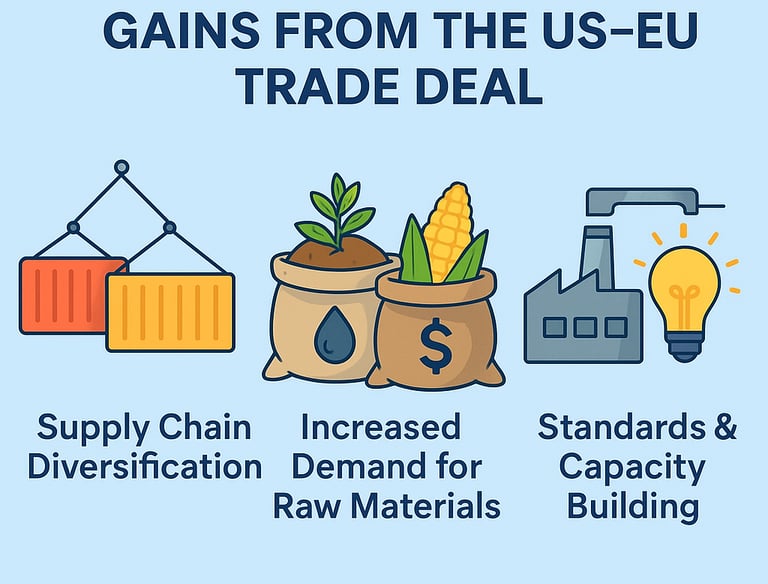Why the Global South Gains from the US–EU Trade Deal
When we talk about major trade deals between global giants like the United States and the European Union, most headlines focus on tariffs, tech rules, or carbon taxes. But there’s a ripple effect that rarely makes the news — and it has everything to do with the Global South. So, what happens when two of the world's largest economies deepen their economic ties? Surprisingly, developing countries across Asia, Africa, and Latin America stand to benefit. Here’s how and why.
RAVINDRA PRAJAPATI
7/28/20252 min read


1. Supply Chain Shifts: The Big Move Away from China
One of the biggest undercurrents of any US–EU trade strategy is reducing dependence on China for manufacturing and critical supplies. That’s where countries like India, Vietnam, Mexico, Indonesia, and Bangladesh step in.
As Western firms diversify their supply chains, they seek new partners in developing nations. This creates export opportunities, new factories, infrastructure investments, and jobs.
Example: If the US imports fewer electronics from China, it may turn to India or Vietnam instead — boosting those economies significantly.
2. Rising Demand for Raw Materials
A successful trade pact between the US and EU naturally boosts production, logistics, and industrial activity. To power this growth, both regions need commodities and intermediate goods.
Guess who provides those? The Global South.
Brazil (soybeans, coffee)
Nigeria (oil)
Indonesia (palm oil, coal)
Chile (copper)
Ghana (cocoa)
With demand rising, commodity-exporting nations benefit from higher volumes, better pricing, and more trade relationships.
3. Investment Spillover: Capital Follows Trade
With trade deals come business confidence — and that often leads to foreign direct investment (FDI).
Multinational companies often build new factories, ports, or tech hubs in developing countries to stay globally competitive. The US–EU pact indirectly promotes this because businesses will look for low-cost, reliable, and regulation-friendly destinations outside of China.
Countries like India, Kenya, or Colombia could see:
More factories
Better ports
Skill development
Job creation
4. Technology & Standards Transfer
Modern trade isn’t just about goods; it’s also about sustainability, cybersecurity, and digital rules. When US and EU firms expand into the Global South, they often bring:
Better regulatory practices
Cleaner technologies
Skill-based training
Cybersecurity tools
This helps local businesses upgrade, become globally competitive, and attract new customers.
5. Indirect Market Access
Not every country is at the negotiation table. But many developing economies can align their regulations and supply chains with US–EU standards to become preferred partners.
It’s a smart way to open doors to Western markets without needing a formal trade agreement.
Think of it as "trading by proximity" — if your goods or services meet their standards, you can still ride the wave.
But There Are Red Flags
Let’s be real: the Global South doesn’t win automatically. They’ll need to:
Invest in infrastructure
Improve governance
Comply with labour and environmental standards
Countries that act quickly can position themselves as global suppliers of the future. Those that delay may miss out.
Final Thoughts: A Strategic Window
While the US–EU trade deal might seem far removed from everyday lives in Jakarta, Nairobi, or São Paulo — its effects are real.
For smart, forward-thinking economies in the Global South, this is a window of opportunity to:
Attract investment
Expand exports
Create jobs
Level up industrial capacity
The world is changing — and those who plug in early will rise faster


Empower your finances.
RAVINDRA PRAJAPATI, Not a sebi registered
FOLLOW Us
ravindra.prajapati1122@gmail.com
+91 9795187745
© 2025. PiPiFinTech All rights reserved.
Contact Us
ABOUT Us
Our mission is to empower you to maximize every single penny and best solution for wealth generation and management for every mature age group.
Product TOPICS
Digital E-Wealth Platform
Mutual Funds
Education Planning
Insurance
FD and Bonds
Retirement Planning
Wealth Creation
(Disclaimers : Mutual Fund investments are subject to market risks, please read scheme related documents carefully.)
